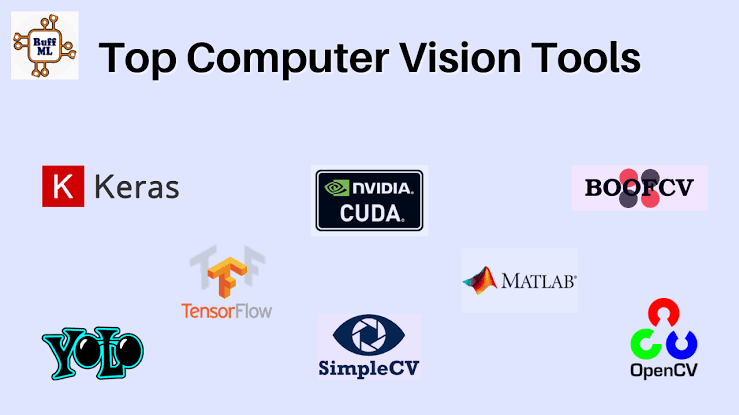Discover the top 10 computer vision libraries that drive advancements in visual recognition and image processing. Explore the features and capabilities of OpenCV, TensorFlow, PyTorch, and more, and find out how these libraries support a wide range of applications from real-time analysis to deep learning.
Computer vision, a branch of intelligence that allows machines to understand and act upon data has made strides in recent years. This progress can be attributed to the development of powerful computer vision libraries that offer tools and algorithms for tasks like image processing, object detection, facial recognition and augmented reality. In this article well delve into the ten most notable computer vision libraries showcasing their features, applications and strengths.
1. OpenCV (Open Source Computer Vision Library)
OpenCV stands out as one of the computer vision libraries celebrated for its extensive functionality and adaptability. Originally created by Intel this open source library supports programming languages such, as C++, Python and Java. It provides a range of capabilities for processing images and videos such as detecting features, segmenting images and tracking objects.
OpenCV stands out for its capability, in processing images and compatibility with platforms like Windows, Linux, macOS and Android. Its commonly utilized in scenarios that demand analysis like video monitoring, robotics and augmented reality.
2. TensorFlow and TensorFlow Lite
TensorFlow, created by Google is a robust framework, for learning that offers support, in computer vision applications. It comes with models and tools to develop and train customized solutions for image classification, object detection and semantic segmentation.
On the hand TensorFlow Lite is a streamlined version of TensorFlow tailored for mobile and embedded platforms. It enables developers to implement learning models on devices with limitations making it suitable for use cases like real time image recognition on smartphones and edge devices.
3. Keras
Keras is a user friendly API for neural networks, developed in Python. It's built to operate on TensorFlow and offers a straightforward interface for creating and training deep learning models in vision. Keras streamlines the process of building intricate neural network designs and comes with models for various vision tasks.
Researchers and developers favor Keras due, to its intuitive interface and adaptability. It supports backends such as TensorFlow, Theano and Microsoft's Cognitive Toolkit (CNTK) making it easy to explore configurations of neural networks.
4. PyTorch
PyTorch, created by the AI Research team at Facebook, is a well known deep learning library that has found favor, in the field of vision. With its dynamic computation graphs PyTorch enables model development and troubleshooting. It offers a range of resources and libraries for vision tasks such as pre trained models, data loaders and transformation tools. Its user friendliness and robust community backing make it a popular option among researchers and professionals involved in vision projects.
5. Scikit-Image
Scikit-Image is a library in Python used for processing images and is part of the broader Scikit-learn framework. It offers a range of algorithms for tasks like manipulating images, extracting features and segmenting them along with tools for analyzing and visualizing images. The library is designed to be user friendly and can easily work with other scientific computing libraries in Python, like NumPy and SciPy. It's especially suited for research purposes and projects that involve intricate image analysis and processing.
6. Dlib
Dlib is a C++ library that comes with Python bindings and is renowned for its powerful learning algorithms and image processing tools. It offers solutions for tasks, like detecting faces, identifying facial landmarks and tracking objects. One of the features of Dlib is its face recognition technology which utilizes trained models to accurately detect and recognize faces. This makes it a choice in applications that involve face detection and analysis, such as security systems and biometric solutions.
7. SimpleCV
SimpleCV is a framework that allows you to create vision applications using Python. Its goal is to offer a user friendly interface for vision tasks making it suitable for newcomers and those seeking a solution for their vision projects.
With features for editing images, extracting features and recognizing objects SimpleCV also integrates with well known libraries like OpenCV and PIL (Python Imaging Library). While it may not have as many features as other libraries its simplicity and user friendliness make it a great option for learning and quickly prototyping ideas.
8. ImageAI
ImageAI is a library that makes it easy to train and deploy tailored object detection models using learning. Its framework is built on TensorFlow and comes with models for tasks like detecting objects and classifying images. What sets ImageAI apart is its user friendly design, providing simplified interfaces for training and testing models. This means that developers can integrate object detection and image recognition into their projects without needing expertise in deep learning.
9. VXL (Vision-something-Libraries)
VXL is a set of libraries in C for vision tasks offering features like image manipulation, extracting key points and adjusting camera settings. Its adaptable structure allows for building vision software and compatibility with other tools in the vision field. VXL's durability and wide range of capabilities make it a valuable asset for both researchers and developers tackling challenging vision issues. Its applicability spans both environments where precise management of vision processes is essential.
Conclusion
The world of computer vision libraries is varied with each one showcasing functionalities and features suited, for specific requirements and scenarios. Whether it's using OpenCV for processing images or leveraging TensorFlow and PyTorch for deep learning these libraries offer robust resources for creating and implementing computer vision solutions. Whether you're engaged in research, industrial endeavors or building applications comprehending the advantages and functionalities of these libraries can assist you in selecting the tools for your computer vision projects.
